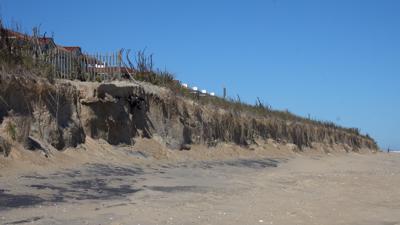DOVER, Del. - Delaware Governor Matt Meyer has sent a letter to President Donald Trump urging him to authorize emergency funding to help restore Delaware’s beaches following the recent nor’easters that brought significant damage to the coastline.
The letter to the president, dated today, Oct. 21, requests federal funding and the activation of the U.S. Army Corps of Engineers to immediately begin emergency restoration efforts on the First State’s beaches under Section 8327 of the Water Resources Development Act of 2022.
Meyer says the section allows the Secretary of the Army to restore public beaches damaged by wind, wave, or water from a storm when the damage prevents adequate protection from inundation, erosion, or more coastal storms. That condition, Meyer argues, has been met.
“Our beaches are part of Delaware’s critical infrastructure that protects homes, roads, and jobs,” Governor Meyer said. “On top of revenue losses and increased costs to the state due to federal legislation, Delaware has been hit hard by recent nor’easter weather. We cannot wait for another storm to hit or for our bridges and highways to collapse to make improvements that will keep our communities safe. We need swift federal action to repair the damage, strengthen our shoreline, and ensure that our coastline is safe and resilient whenever the next storm hits.”
Meyer’s office says a resolution passed by Republicans in Congress and signed by Trump earlier this year cut significant funding for beach replenishment in coastal states. The cuts follow a pattern of federal funding changes that include withholding hundreds of millions in emergency preparedness grants to states opposing the president’s immigration and deportation policies, according to Meyer.
“Delaware’s coastal communities, economy, and infrastructure rely on USACE-maintained beaches to provide storm surge and flood protection,” Meyer’s letter reads. “Immediate restoration will prevent further loss and protect people, homes, and small businesses. When natural protective barriers fail, emergency routes become impassable, evacuation corridors are threatened, and stormwater systems are overwhelmed—placing residents and first responders in danger. More delays will only increase risks to life and property and drive-up long-term disaster recovery costs.”
WBOC went out to Bethany Beach on Wednesday, October 22nd, where the coast was still facing erosion issues after the recent nor'easter. Many of the beaches central access points were also still closed. People who both live in the beach town and who are frequent visitors expressed their hope that the letter gets them federal support.
"I was so shocked when I saw the beach," Lisa McCormack said. "You could almost break your arm or your leg if you fell down. And I thought, what the heck? I almost started crying."
McCormack said repairing the coastline in towns like Bethany Beach is vital.
"It's America's shoreline, and the federal government should step in. Because so many people from all over the country and from different states come here to Delaware," McCormack said. "Delaware takes care of it the best that it can, but Delaware can't do it alone. It needs federal help."
Bethany Beach Mayor Ron Calef also told WBOC he hopes the letter garners national attention.
"I'm ecstatic that he wrote that letter. I think it's great," Calef said. "I hope we get something out of it. Unfortunately, I don't have a lot of faith in this federal government."
Calef said it has been a struggle at times to garner federal funding for beach replenishment projects, but that they could use the support after the recent storms.
"I'd like to see some replenishment this year," Calef said. "It's not going to happen right away, but something in the spring would be wonderful, because we don't know what's gonna happen this winter."
Calef said it's important on multiple levels to protect coastal towns like Bethany Beach.
"They're important to protect because of the town itself, but also, with all of the people moving here and the tourist industry, you have to also look at the economy and the entire economy of the entire state," Calef said.



